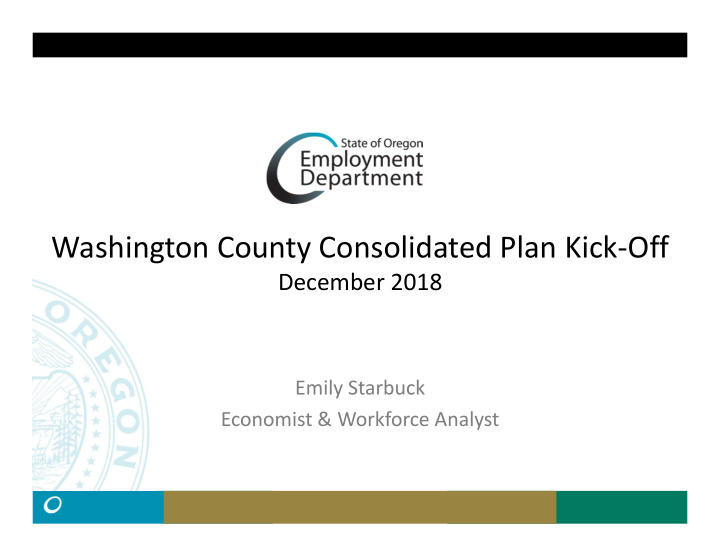



Washington County Consolidated Plan Kick ‐ Off December 2018 Emily Starbuck Economist & Workforce Analyst
LOCAL STRENGTHS
Washington County Leads Regional Employment Growth 120 18% 15% 115 13% 110 9% 105 100 95 90 85 80 Portland Metro Washington County Multnomah County Clackamas County Seasonally adjusted. Source: Oregon Employment Department, Current Employment Estimates, Apr. 2008 to Oct. 2018
Washington County Has Lower than Average Unemployment 12.0% 10.0% 8.0% 6.0% 4.0% 3.7% 4.0% 3.5% 3.3% 2.0% 0.0% Portland Metro Washington County Multnomah County Clackamas County Seasonally adjusted. Source: Oregon Employment Department, Local Area Unemployment Statistics, Apr. 2008 to Oct. 2018
Washington County is Younger, More Diverse, and More Highly Educated Portland Washington Multnomah Clackamas Indicator MSA County County County Median Age 38.2 36.9 37.3 41.6 Median Household $71,931 $80,946 $63,974 $79,878 Income Percent People of 26.8% 34.2% 30.4% 18.2% Color Percent with a Bachelor’s Degree or 40.3% 45.8% 45.4% 38.4% Higher (25+ years) Source: US Census Bureau, American Community Survey, 2017 1-year estimates, tables S0101, S1903, S0501, S1501
Washington County Has Highest Average Wages in the State; Second Highest Wage Growth in Metro Area $80,000 10% 9% $68,168 $70,000 8% $57,173 $60,000 7% $51,724 $51,117 $50,000 6% $40,552 $38,808 $40,000 5% 4% $30,000 3% $20,000 2% $10,000 1% $0 0% Oregon Washington Multnomah Clackamas Yamhill Columbia 2017 Annual Average Wage Real Wage Growth 2012 ‐ 2017 Inflation adjusted. Source: Oregon Employment Department, Quarterly Census of Employment and Wages, 2012 & 2017
AREAS OF WEAKNESS
28% of County Households are Low Income Extremely low income, 7% Very low • 61,312 households income, 7% 138,476 people • • Lower than Multnomah County – 39% low income Low income, 14% • On par with Clackamas County – also 28% low Not low income, 72% income Source: US Census Bureau, American Community Survey Public Use Microdata, 2017 1 ‐ year estimates for Washington County
Low Income Residents are More Diverse and Less Highly Educated Indicator County Average Low Income Residents Median Household Income $80,946 $34,380 Percent People of Color 34.2% 43.2% Percent with a Bachelor’s Degree 45.8% 28.1% or Higher (25+ years) Labor force participation rate (age 85.1% 74.2% 25 ‐ 54) Percent under 18 23.3% 26.0% Percent 65 or older 12.9% 17.9% Source: US Census Bureau, American Community Survey Public Use Microdata, 2017 1 ‐ year estimates for Washington County
Race & Poverty Census tracts where people of color make up 34%+ of population Source: US Census, American Community Survey, 2013-2017 5-year estimates
Race & Poverty Census tracts with the county’s highest poverty rates Downtown Forest Grove, Hillsboro, 45% 23% South Downtown Hillsboro, Beaverton, 24% 30% Durham/ Rivergrove, 33% Source: US Census, American Community Survey, 2013-2017 5-year estimates
People of Color Make Up 32% of Full ‐ time Workforce, But Are Overrepresented in Lower Income Tiers 50,000 45,000 Over 32% People Under 32% of Color People of Color 40,000 31% 35,000 30,000 23% 28% 25,000 32% 37% 20,000 43% 15,000 24% 10,000 48% 5,000 ‐ <$20k $20 ‐ 30k $30 ‐ 40k $40 ‐ 50k $50 ‐ 65k $65 ‐ 75k $75 ‐ 100k >$100k White People of Color Source: US Census Bureau, American Community Survey, 2017 1-year estimates, Washington County
CURRENT OPPORTUNITIES
Median Rents Stabilizing in 2018 $2,500 $2,000 $1,868 $1,500 $1,522 $1,000 $500 $0 Oct ‐ 11 Apr ‐ 12 Oct ‐ 12 Apr ‐ 13 Oct ‐ 13 Apr ‐ 14 Oct ‐ 14 Apr ‐ 15 Oct ‐ 15 Apr ‐ 16 Oct ‐ 16 Apr ‐ 17 Oct ‐ 17 Apr ‐ 18 Oct ‐ 18 Single Family Multifamily Source: Zillow Rent Index (ZRI), Oct. 2011 to Oct. 2018, Washington County
Fastest ‐ Growing Occupations in the Portland Area Provide Opportunities at All Education Levels 2017 ‐ 2027 Projected Growth Occupation Entry ‐ Level Education Rate Home health aides 36.1% Less than high school Health specialties teachers, postsecondary 31.5% Master’s degree Software developers, applications 31.0% Bachelor’s degree Medical assistants 29.9% Postsecondary training Doctoral or professional Physical therapists 29.6% degree Market research analysts & marketing 28.6% Bachelor’s degree specialists Financial managers 27.0% Bachelor’s degree Personal care aides 23.7% High school diploma Massage therapists 23.2% Postsecondary training Transportation, storage and distribution 22.7% Bachelor’s degree managers Occupations with at least 1,000 employed in 2017 Source: Oregon Employment Department, 2017-2027 Occupational Employment Projections, Portland Tri-County
FUTURE CHALLENGES
Slower Projected Growth in a Core Industry Professional and business services 18% Health care and social assistance 20% Government 7% Leisure and hospitality 14% Manufacturing 5% Retail trade 10% Financial activities 6% Construction 17% Wholesale trade 8% Total projected Other services 10% growth: 12.7% Transportation, warehousing, and utilities 23% Private educational services 17% Information 12% Natural resources and mining 8% 0 20,000 40,000 60,000 80,000 100,000120,000140,000160,000180,000200,000 2017 Employment 2027 Employment Source: Oregon Employment Department, 2017-2027 Industry Employment Projections, Portland Tri-County
Slower Projected Growth in a Core Industry Computer and electronic product manufacturing 2% Food manufacturing 18% Fabricated metal product manufacturing 4% Machinery manufacturing 8% Transportation equipment manufacturing 0% Total projected growth: 5% Primary metal manufacturing 0% Wood product manufacturing 0% Paper manufacturing ‐ 10% ‐ 5,000 0 5,000 10,000 15,000 20,000 25,000 30,000 35,000 2017 Employment 2027 Employment Source: Oregon Employment Department, 2017-2027 Industry Employment Projections, Portland Tri-County
Through 2025, 16% of Oregon’s Population Growth Will Be in Washington County Washington County +63,000 (10.5%) Multnomah County +53,000 (6.5%) Clackamas County +41,000 (9.8%) Source: Portland State University Population Research Center, 2018 Preliminary Estimates & Cycle 1 Population Forecast
Recommend
More recommend